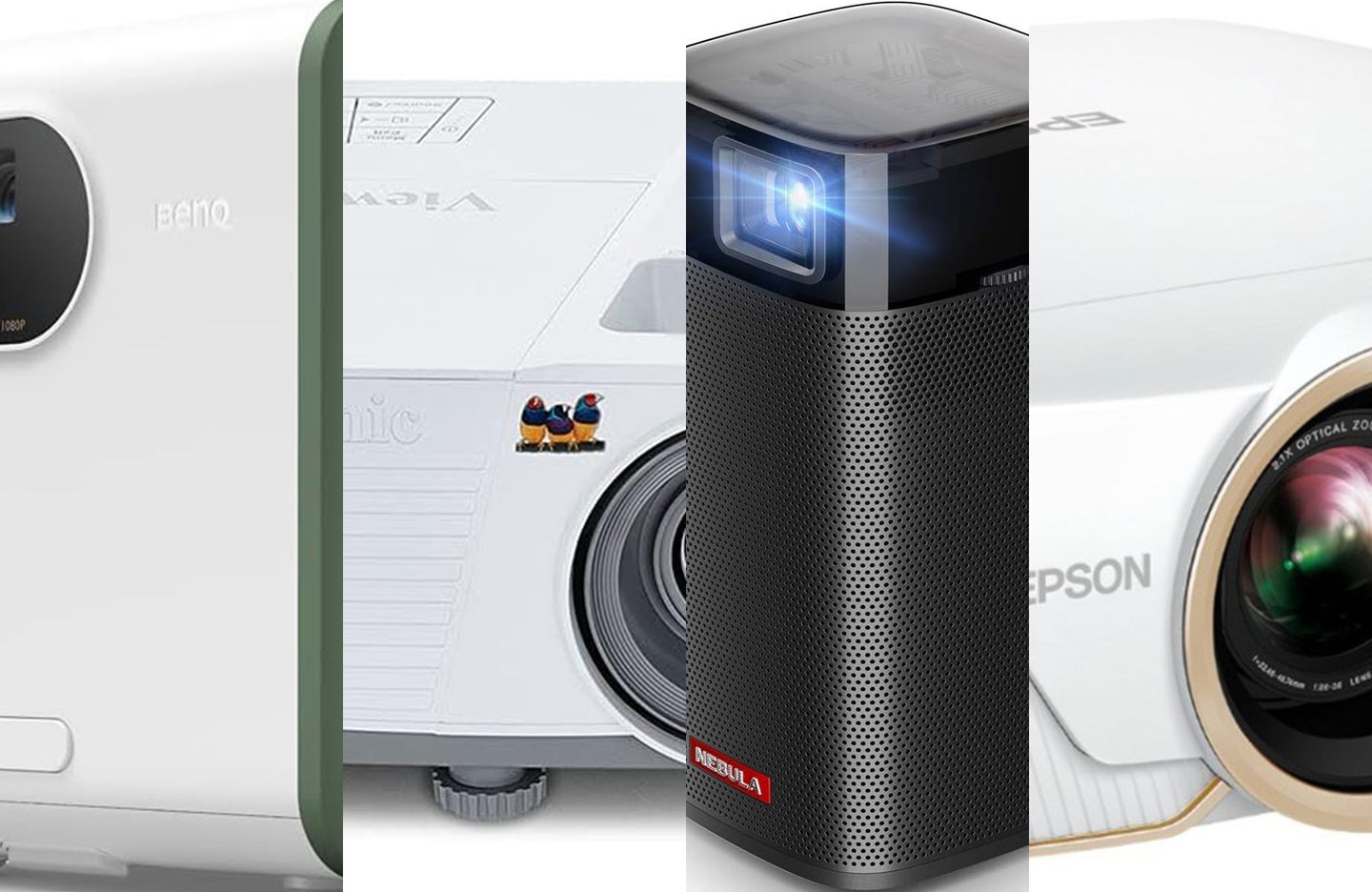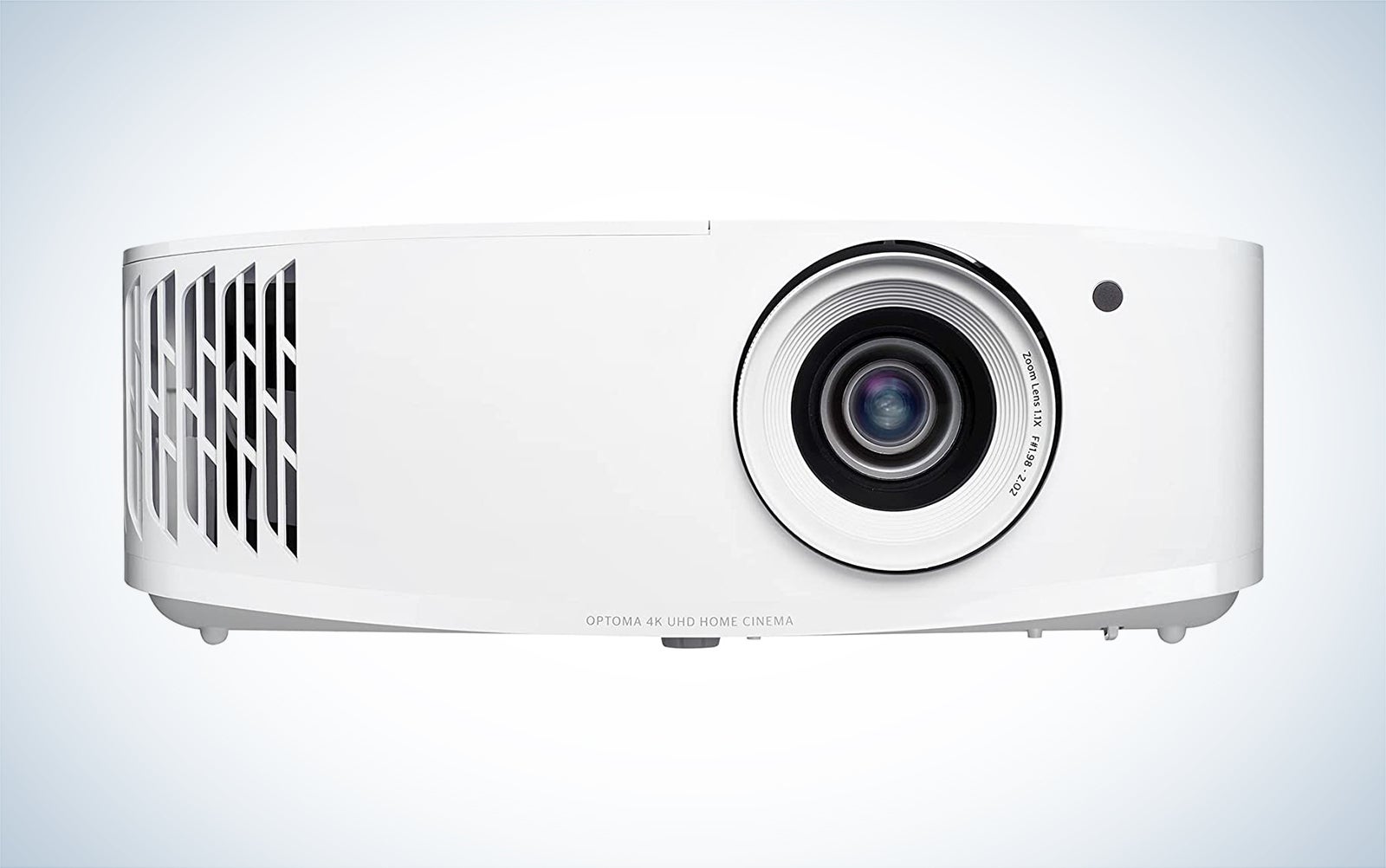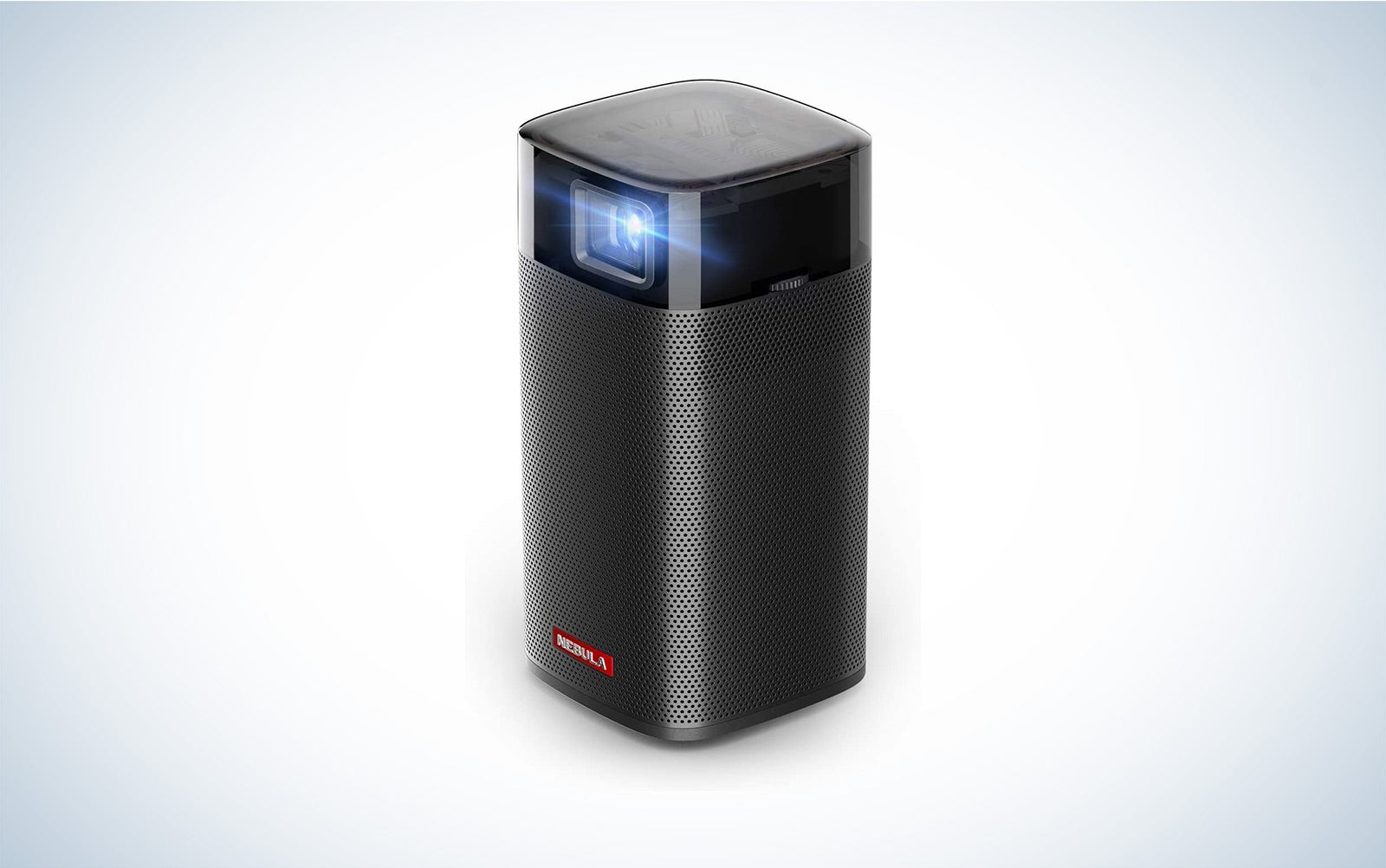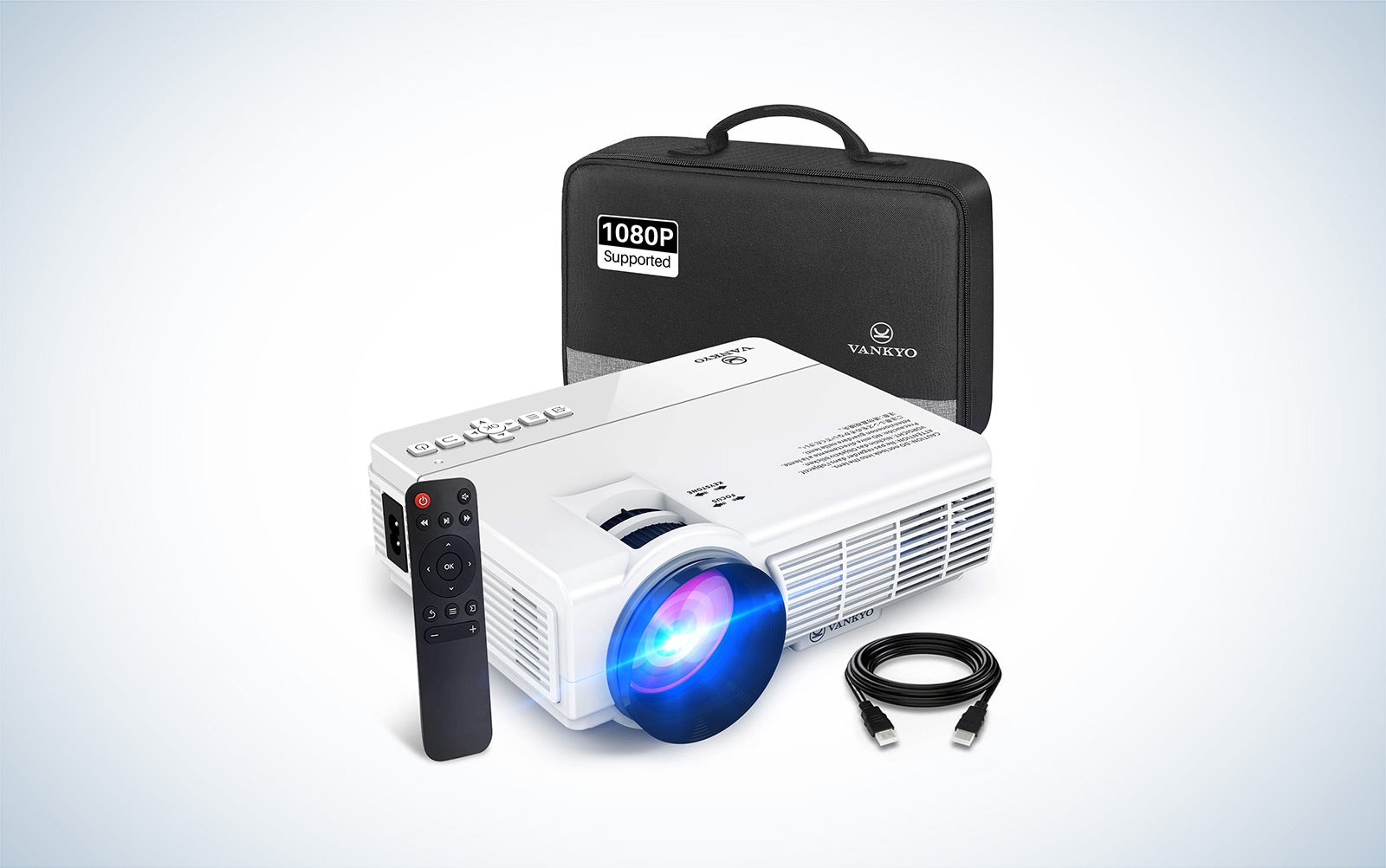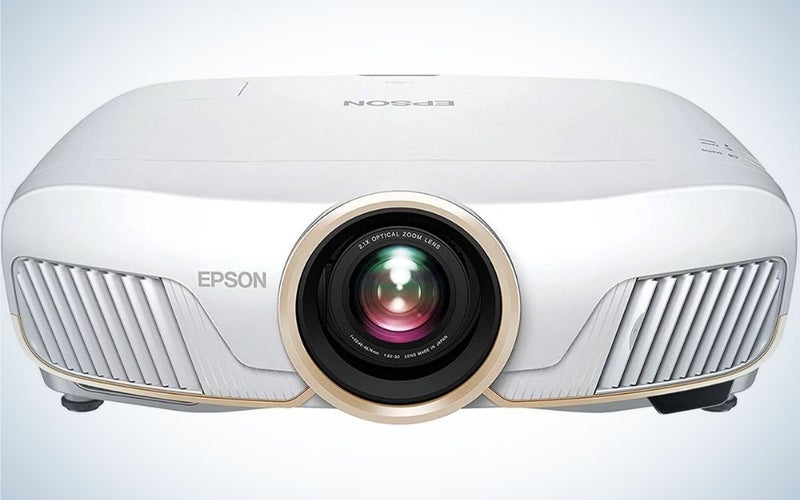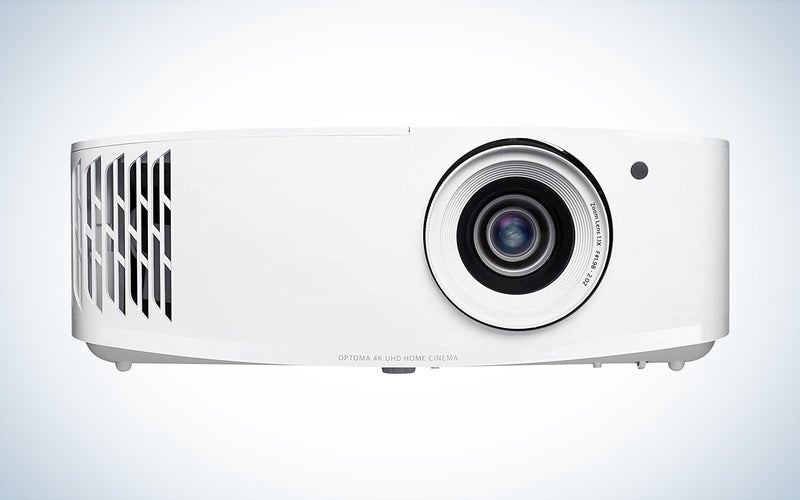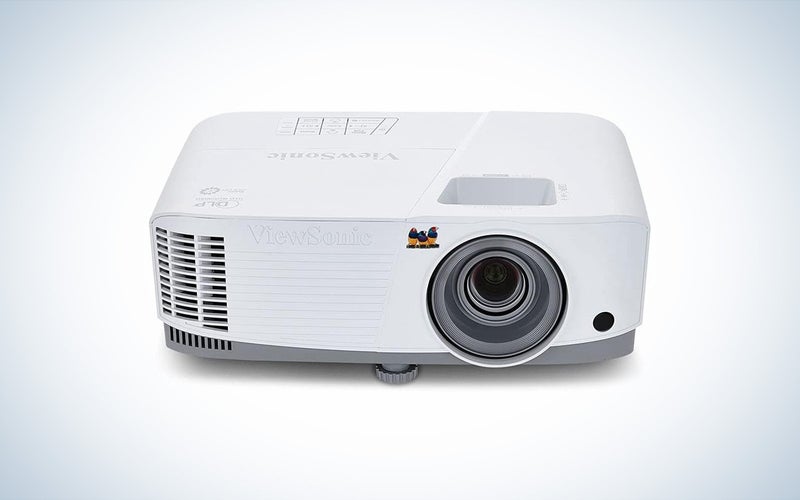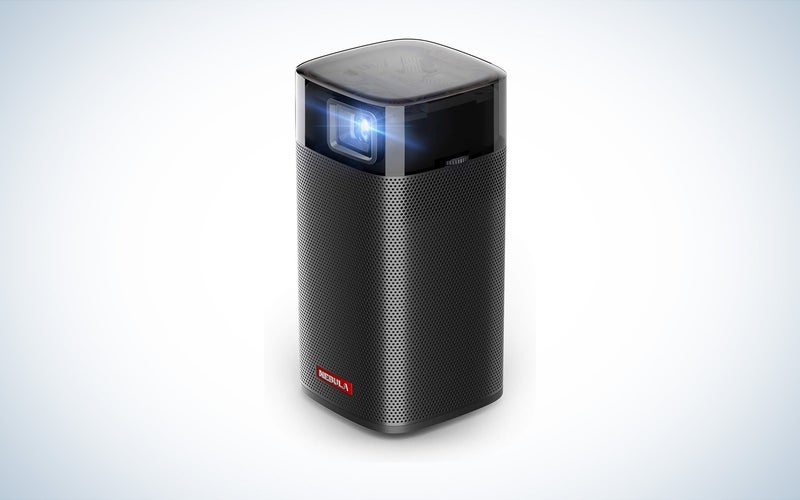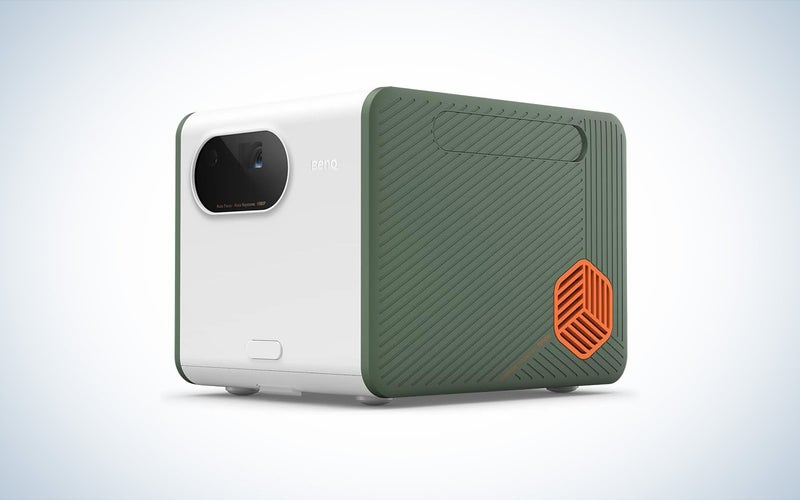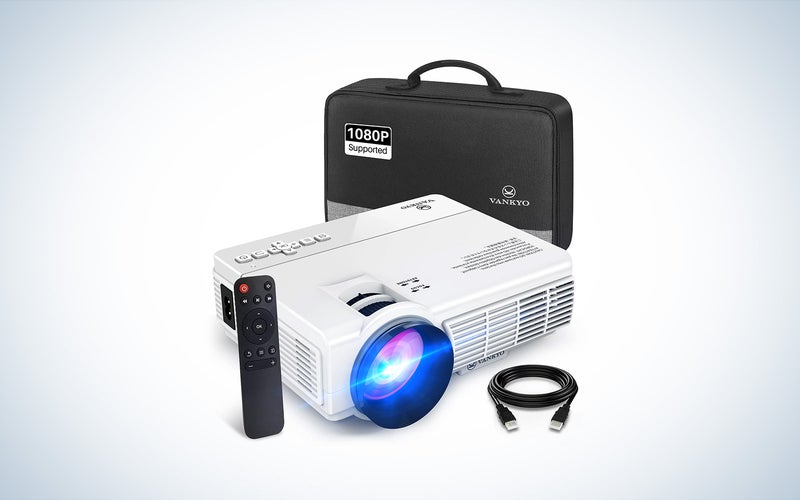We may earn revenue from the products available on this page and participate in affiliate programs. Learn more ›
Sometimes, you just want to see the big picture, and that’s exactly what projectors allow you to do. By taking in data from a connected device, projectors use light and lenses to display an image that can be more than double the size of a big-screen TV with a picture that is just as vivid. Whether you’re creating the perfect home cinema, building a better boardroom, or hoping to enjoy a movie night under the stars, we’ll help you find the best projector.
- Best home-theater: Epson 5050UB
- Best gaming: Optoma UHD35x
- Best office: ViewSonic PA503S
- Best portable: Anker Nebula Apollo
- Best outdoor: BenQ GS50
- Best budget: VANKYO Leisure 3
How we chose the best projectors
When selecting the projectors included in this guide, we aimed to choose options suitable for a range of situations and use cases. From home theater to office setups and even outdoor movie night devices, we looked for projectors that would fit the needs of everyone. We looked at a range of features and specs, including brightness, contrast, ratio, refresh rate, resolution, projector type, throw distance, and more.
The best projectors: Reviews & recommendations
With their ability to display big pictures, projectors can turn your living room into a cinema or your office’s conference room into a lecture hall. Here are the options, whether you’re in the market for a home-theater model, a gaming projector, or a portable option.
Best home-theater: Epson 5050UB
Epson
Specs
- Resolution: Up to 4096 x 2160
- Contrast ratio: 1,000,000:1
- Brightness: 2600 Lumens (color and white)
- Projection size: 50 – 300 inches
- Built-in speaker: No
- Dimensions: 20.5 x 7.6 x 17.7 inches
- Weight: 24.7 pounds
Pros
- Superb picture quality
- Excellent contrast ratio
- Lots of lens shift and zoom options
- Supports HDR
Cons
- Bulky and heavy
- Pricey
The Epson 5050UB offers 2,600 lumens for color and white brightness and a contrast ratio of 1,000,000:1. And with its 10-bit HDR processor and 12-bit digital imaging processor, it is the best home-theater projector, delivering cinema-quality picture to your living room. The motorized lens provides powered focus, 2.1x zoom, and both horizontal and vertical lens shift. You’ll be able to get the picture just right now matter where or what you are watching.
The 4K resolution is vivid thanks to the pixel-shift processor that controls three HD LCD chips, taking in millions of pixels. That means you’ll see all the details you expect to see—and some that the actors would prefer you not be able to see. With a variety of ports, this pick can connect to many devices, ranging from a laptop and smartphone to a Roku and Blu-ray player. Retailing at about $3,000, this powerful home theater option is pricey, but you may never have to pay for a movie ticket again.
Best gaming: Optoma UHD35x
Optoma
Specs
- Resolution: Up to 3840 x 2160
- Contrast ratio: 1,000,000:1
- Brightness: 3600 Lumens
- Projection size: 33 – 300 inches
- Built-in speaker: Yes
- Dimensions: 12.4 x 4.7 x 10.6 inches
- Weight: 8.77 pounds
Pros
- Bright enough to use in the daytime
- Gaming-specific mode offers smooth playback
- Excellent picture quality
- Very quiet
Cons
- Limited adjustment features
The Optoma UHD35x offers a super-low input lag of 4.2ms at 1080p and a high refresh rate of 240Hz. It can optimize your gaming with a silky-smooth feed that won’t skip a beat, even during heart-pumping action sequences. The DLP projector also excels as a home-theater projector, delivering 4K resolution that pops with 8.3 million screen pixels—four times the detail of full HD.
The 3,600 lumens of brightness and a 1,000,000:1 contrast ratio create superb color contrast. It’s bright enough to use even in well-lit rooms or during the day. The best gaming option is also HDR-, HLG-, and full 3D-compatible, and it features dual HDMI ports so that you can connect your console and your laptop simultaneously.
Best office: ViewSonic PA503S
ViewSonic
Specs
- Resolution: Up to 1920 x 1200
- Contrast ratio: 22,000:1
- Brightness: 3600 Lumens
- Projection size: 30 – 300 inches
- Built-in speaker: Yes
- Dimensions: 11.6 x 4.3 x 8.6 inches
- Weight: 4.89 pounds
Pros
- Reasonably priced
- Easily viewable in bright rooms
- Long-lasting lamp
- Preset modes make setup easy
Cons
- Lower resolution doesn’t offer much detail
- Contrast ratio is lacking
Even in a bright conference room, your colleagues or clients should have no trouble viewing your presentation. This office projector features 3,800 lumens of brightness and a 22,000:1 contrast ratio. It offers built-in speakers, so you don’t have to fuss with something extra during a presentation. And there is a Quick Power Off option which allows you to put it away immediately instead of waiting for the fans to stop spinning.
The contrast ratio may be low, but this ViewSonic is designed to be energy-efficient. The lamp can last up to 15,000 hours thanks, in part, to a SuperEco mode that dims any projected image by 70 percent when the device hasn’t received an input signal for 20 minutes. That’s ideal in an office setting, where a moment of neglect after a meeting could result in hours—or even an entire weekend—of wasted energy. The ViewSonic also offers five viewing modes, including presentation, photo, and movie modes, and it’s compatible with Mac and Windows computers, as well as Google Chromecast.
Best portable projector: Anker Nebula Apollo
Anker
Specs
- Resolution: Up to 854×480
- Contrast ratio: 400:1
- Brightness: 200 ANSI lumen
- Projection size: 40 – 100 inches
- Built-in speaker: Yes
- Dimensions: 2.56 x 2.56 x 5.16 inches
- Weight: 1.65 pounds
Pros
- App connectivity turns your phone into a remote
- Up to 4 hours of battery life
- Compact and easily portable
- Lots of connectivity options
Cons
- Picture quality is a little lacking
The best portable projector gives you the power to put on a show wherever you go, and Anker’s Nebula Apollo does exactly that. The wireless model with 200 lumens of brightness can stream up to four hours of 854×480 resolution video on a 100-inch picture. That’s perfect for an outdoor movie night or for watching the game under the moonlight.
The tripod-mountable DLP device also features a 6W speaker, taking care of the audio as well as the visuals. It can even function as a Bluetooth speaker if you just want music with you on the go. And it’s designed to be user-friendly, with a touch-panel control on top and a downloadable app that lets you direct the action from your smartphone.
Best outdoor: BenQ GS50
BenQ
Specs
- Resolution: Up to 3840 x 2160
- Contrast ratio: 100,000:1
- Brightness: 500 Lumens
- Projection size: 80 – 100 inches
- Built-in speaker: Yes
- Dimensions: 7.3 x 6.1 x 5.7 inches
- Weight: 5.1 pounds
Pros
- Rugged build makes it ideal for outdoor use
- Attractive styling
- Good picture quality
- Impressive speaker quality
Cons
- A bit pricey
Outdoor movie nights are a blast, but you don’t want to risk your expensive projector getting rained on or bumped to the ground. The BenQ GS50 offers a solution thanks to the robust build quality. It is splashproof and drop proof to 2.3 feet. And though it doesn’t add anything to functionality, it just looks cool.
This BenQ projector offers lots of unique features that make it extra ideal for outdoor use. The 20W sound system offers plenty of volume to be easily heard outside. The ambient light sensor automatically adjusts brightness and contrast to compensate for shifting light. And it provides 150 minutes of battery life for video use. Additionally, the GS50 is packed with family-friendly features, such as the Eye-Protection Sensor that temporarily shuts the projector down if a child gets within 11.8 inches.
Best budget: VANKYO Leisure 3
VANKYO
Specs
- Resolution: Up to 1920 x 1080
- Contrast ratio: 5000:1
- Brightness: 2400 Lumens
- Projection size: 32 – 200 inches
- Built-in speaker: Yes
- Dimensions: 7.9 x 5.9 x 3.1 inches
- Weight: 2.1 pounds
Pros
- Very affordable
- Comes with a carrying case
- Quiet fans don’t compete with the speaker
- Supports HDMI, VGA, USB, and microSD or SD cards
Cons
- No Wi-Fi connectivity
If you’re looking for an affordable, compact projector, the Vankyo Leisure 3 is one of the best available. It comes with a carrying case, and with its compact size, you can easily bring it with you when traveling or visiting a friend. It also features a built-in speaker, so you don’t need to worry about bringing something separate for sound.
The Leisure 3 offers a resolution of up to 1920 x 1080, which is excellent considering the price. The picture quality won’t be the same as more expensive models, but it can project up to 200 inches for immersive movie nights. And it supports a range of connection types and devices, adding flexibility.
What to consider when shopping for the best projectors
Gaming projectors can be different from home-theater models, which can be different from office projectors, which can be different from portable projectors. Light sources, processors, lenses and pixels all factor in—and can vary from one option to the next. But sorting through all of it can leave your brain feeling understandably fuzzy. Here’s what you need to know to find the best projector for clear and stunning images, no matter where you want to view them.
How big of a picture are you hoping to display?
The big advantage of a projector is that it can give you a bigger picture than a TV for a smaller price. But the size of that picture is not as simple as buying a 60-inch-screen TV and getting a 60-inch picture. The dimensions of the image you get from a projector are determined by the throw ratio. The throw ratio is the width of the picture you’ll see when you mount or sit the device a set distance from the screen. Generally speaking, the farther away you’re able to set the projector from the screen, the bigger the image will be. For instance, a ratio of 1.5:1 would produce a 5-foot-wide image when the projector was 7.5 feet from the screen (5×1.5).
To produce a 10-foot-wide picture with the same projector, you’d need to place the device 15 feet from the screen (10 x 1.5). So if you’re hoping for a big picture, but you’re planning to put it in a small room, you should look for a short-throw projector that is capable of producing a larger image at closer distances. You can also find models with zoom lenses that allow you to change the image size without relocating the projector.
Will you be using your projector in a well-lit room?
If you’re planning to set up your projector in a room with a lot of ambient light, you’d be wise to pay extra attention to brightness. The first step might be deciding whether you’re looking for a digital light processing (DLP) or a liquid crystal display (LCD) projector. LCD tends to produce a brighter picture in brighter rooms, but DLP excels at creating a smoother picture with higher color contrast.
Next, consider the type of light source in your projector. Standard lamps are cheaper and brighter than LED lamps, but LED lamps last more than four times as long and provide better color control. Lasers, meanwhile, never need to be replaced, offer the brightest output, and offer better color contrast and a wider color range than standard lamps. Of course, laser projectors tend to cost more than other projectors.
How do you know how bright of a picture your projector will produce as a result of all this? The light output for color brightness and white brightness is measured in lumens. But brighter isn’t always better. If you’re in the market for a home-theater projector or a gaming projector that you’ll mount in a room where you’ll have full control over the lights, you should prize color contrast over brightness for a crisper picture that doesn’t wash out as easily.
The contrast ratio can help you find the right balance, measuring the difference between the lightest and darkest spots on the image. A projector with a high-contrast ratio produces images with more depth and clarity, while a lower contrast ratio works better at the office, where the projector may be used in a bright conference room, with ambient light dulling the picture.
Looking for clarity?
If you’re looking for a sharp, clear image, you’ll want to prioritize resolution. Resolution measures the number of pixels a projector is capable of showing in an image. The higher the resolution, the closer you can sit without the picture blurring. Projectors offer resolutions that range from 480p up to 4K.
To ensure you’re getting the clearest picture, make sure the device can support the resolution of the video source you’re linking it to. Most feature multiple input options, including USB, HDMI, and VGA. Also, look for a projector with the right aspect ratio for the kind of display you want. A 16×9 ratio gives you a wider screen (typically better for home movies), while a 4×3 ratio is closer to a square (typically better for office presentations).
Does your high-octane gaming demand low lag time?
When you’re about to beat the boss to move onto the next level, or your team is racing up the court for a buzzer-beater, you can’t have a choppy picture. This is where the DLP versus LCD displays come back into play. DLP is better equipped to support a smooth picture in fast action, while LCD provides a more vivid depiction of graphs, data, and 3D pictures. Liquid crystal on silicon (LCoS) displays are available in more expensive projectors, offering the best of both worlds, with bright images, smooth scenes, and excellent color control.
FAQs
Q: Which brand is best for a projector?
It’s hard to say definitively which brand is best for a projector, especially as several brands offer models for various uses. Epson, Sony, Optoma, and ViewSonic are among the leading manufacturers, but other makers pump out powerful projectors, as well.
Q: Are projectors better than a TV?
Projectors are better than a TV if you’re looking for a bigger screen at less cost. Though it’s worth noting that a big picture from a projector may require a large room to position the device farther back from the screen. TVs can also provide a clearer picture in a bright room, include superior sound systems, and require less maintenance; their lamps burn out.
Q: Do projectors consume a lot of electricity?
Projectors vary in how much electricity they consume, ranging from about 50 watts up to 800 watts—or roughly from the consumption of a light bulb to a coffee maker.
The final word on shopping for the best projectors
- Best home-theater: Epson 5050UB
- Best gaming: Optoma UHD35x
- Best office: ViewSonic PA503S
- Best portable: Anker Nebula Apollo
- Best outdoor: BenQ GS50
- Best budget: VANKYO Leisure 3
Projectors can give you a big picture that’s as stunning as any high-definition TV. But finding the best projector for you comes down to knowing where you’re going to use it and what you’re going to use it for. Do you need a gaming model with super-fast processing or a portable pick that lets you take the show on the road? Before you’ve attached it to your ceiling, make sure you’ve truly found the right fit.
Why trust us
PopPhoto has a long history of delivering the opinions of some of the sharpest and most prolific camera dorks the world has to offer. Since 1937, we’ve been reviewing cameras, providing wisdom from well-known photographers, and generally just nerding out about all that goes into making great pictures. Our current crop of writers and editors have decades of professional photography and camera writing experience among them. Collectively, we’ve probably shot with just about every camera and lens combo you can imagine—as well as some obscure stuff you may not even know about. Remember the Casio Tryx folding camera? PopPhoto does.
We also get that buying a camera is a big decision, which is why we’re dedicated to helping folks choose the right one (or, in our case “ones”) for their needs. Case in point: Handing over top dollar for an expensive rig may leave you unsatisfied if it doesn’t fit your preferred shooting style. Sure, a $6,000 sports-oriented DSLR can capture landscapes, but do you really need to do it at 30 frames-per-second? No, you don’t.
Related: Keep an eye on your home with the best home security cameras.
